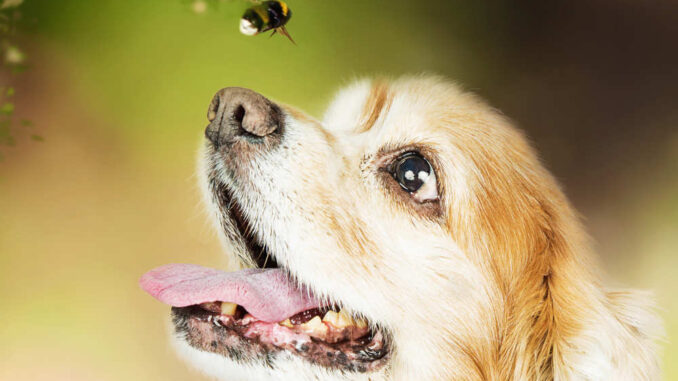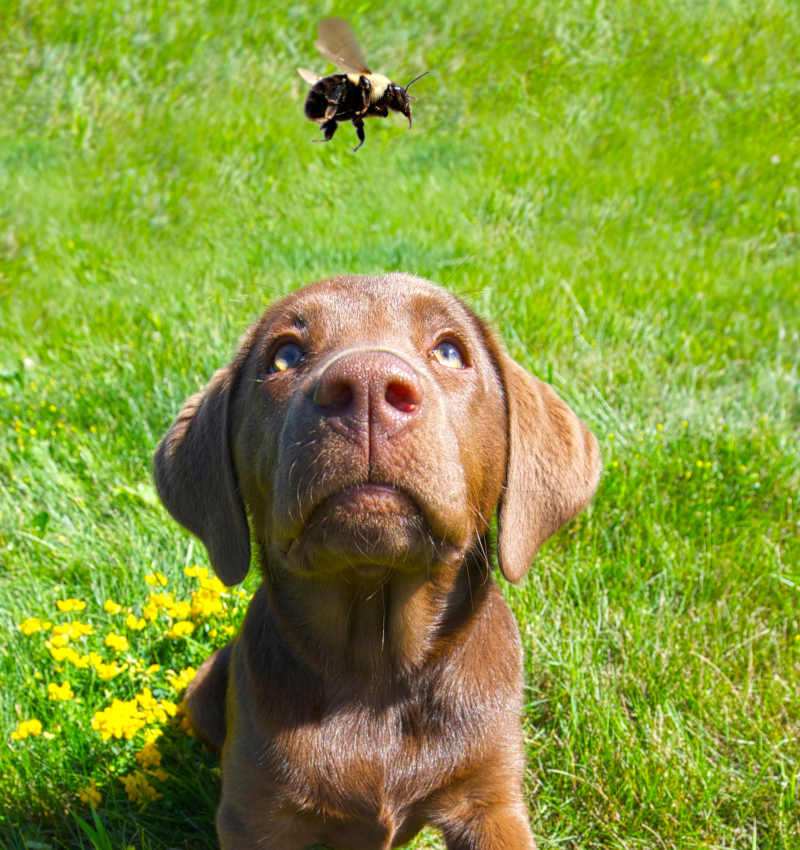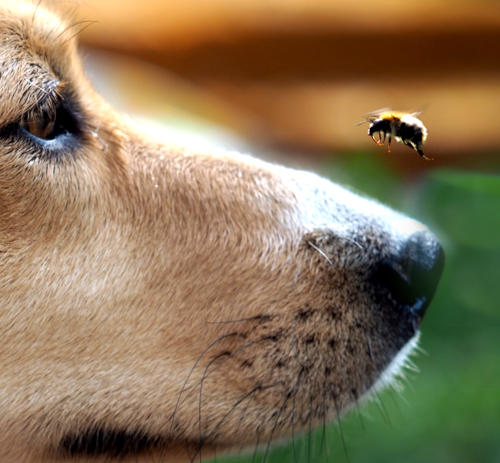
In this article, our veterinarian Dr. Chyrle Bonk shares essential steps to take when your dog eats a bee.
Just Eating a Bee Usually Presents No Problem
“Just eating a bee usually presents no problem for the dog: the bee will die and be digested just like any other food that goes into your dog’s mouth. It may even provide a little bit of protein. However, you need to monitor for signs that your dog has been stung in the nose, mouth or throat – this could be an emergency.”
The trouble with eating bees is if it happens to sting your dog before it dies.
With the sting, bees release venom into the tissue that can cause a reaction, including swelling, redness, pain, and heat. Reactions can be mild and not really affect a dog, or they can be severe and cause serious and immediate problems.
The biggest trouble with eating bees is that getting stung in the nose, mouth, or throat can be very bothersome and cause swelling that can block the airways.
Call your Vet Immediately If Your Dog Has Difficulty Breathing, Looks Weak, Vomits or Collapses
Watch for important signs: see your veterinarian immediately if you see any of the following signs:
- difficulty breathing: if there may be an issue with swelling blocking an airway, see your veterinarian immediately.
- weakness or incoordination,
- vomiting or diarrhea,
- collapse,
- any other signs of illness or distress

If your dog appears to act normal with no immediate signs of distress or illness, we recommend going through these steps:
- First, remain calm. This isn’t a panic situation unless you know that your dog is allergic to bees. You may miss something if you panic, so keep your cool.
- Check your dog for stings. Check paws, face, nose, lips, tongue and the inside of his mouth for any redness, swelling, or painful spots. Dogs may drool, lick or favor areas that have been stung. He may also develop hives or itchiness.
- If you notice a sting, check for swelling: if you notice a sting on the paws, face, or mouth, note the size of the swelling and if there is any danger that it could impede an airway.
An important note about allergies to bees: dogs that are allergic to bees will have the worst response. Allergic responses take a localized bee sting and turn it into a whole-body problem. Dogs that are allergic to bees may develop difficulty breathing, have vomiting, diarrhea, weakness, and even collapse. All this means is that it’s possible for a dog to die from eating a bee if your dog is stung before the bee dies.
Monitor Your Dog for 12-24 Hours

Most serious reactions to bee stings are going to happen within a few minutes, so you won’t have to wait around to decide if you should go to the vet or not. If you can’t find an obvious bee sting or he has been stung in an area where there is no immediate danger, you may choose to monitor him for 12-24 hours.
- Keep track of the amount of swelling and note any changes.
- If the sting is in an area that could cause breathing difficulties, such as the nose or throat, see your veterinarian.
Most severe, allergic reactions will happen within a few minutes of a bee sting. So, if your pup shows any vomiting, diarrhea, incoordination, difficulty breathing, or weakness minutes after eating a bee, get to your nearest veterinary emergency hospital.
Is There Anything I Can Do at Home If My Dog Eats a Bee?
Eating the bee isn’t the concern, it’s the possibility of getting stung that becomes the issue. If your dog happens to eat a bee, you can first check him over for any signs of a sting. Don’t forget to the check the paws, especially between the toes, since he may have been stung there first and then ate the bee out of agitation.
Whether you do or don’t find any swelling or redness indicating a bee sting, monitor your dog for any reactions. Besides the swelling or redness at the site of the sting, you may also note limping, lameness or licking of his paws. He may also lick his nose or lips if there was a sting there. Drooling or pawing at his mouth may occur if the sting was inside.
More serious symptoms to watch out for include difficulty or noisy breathing, agitation, vomiting, diarrhea, weakness, pale gums, and collapse. These require emergency treatment.
If your dog is showing mild symptoms or you notice mild signs, start by first removing the stinger, if there is one present. Scrape it with your fingernail or the edge of a credit card rather than trying to grab and pinch it. Honeybees are the only ones that leave behind a stinger, so if your dog is stung by any other bee, this won’t be a problem.
You may then want to make a paste by mixing baking soda with a bit of water and applying it to the sting. This may help to neutralize the acidity of the venom. Of course, if the sting is in your pup’s mouth, this isn’t really an option. You can also apply a cool compress to help reduce any swelling. Never apply ice or an ice pack directly to your dog’s skin, instead wrap it in a towel first to prevent injuries.
Multiple bee stings or stings inside the mouth, nose, or throat may require an antihistamine to help control swelling. Contact your veterinarian for the proper type and dose of antihistamine to use.
Serious allergic reactions should be seen by a vet immediately.
How Can a Vet Help?
If your pup is showing any worrisome signs or if you would just feel better having him checked out after eating a bee, feel free to see your veterinarian.
- If your dog is showing mild to moderate signs, your vet will first check him over to assess how many stings and where they are. They then may give antihistamines, if warranted, or advise using cool compresses and monitoring.
- Severe signs may require IV fluids, steroids, antihistamines, and even epinephrine. Time is of the essence, so if your dog has a known bee allergy, he’s showing any worrisome signs, or you just want peace of mind, don’t hesitate to take him to the vet.
Is There a Difference Between Wasp, Hornet, Yellow Jacket or Bee Stings in Dogs?
All stings are going to painful and possibly cause a localized reaction in your dog. However, there are some differences between stinging insects.
Bees: First of all, bees have a barbed stinger that they lose when they sting. They only get one shot and then they die. To make up for that, bee venom tends to be nastier, causing bigger reactions. Removing the stinger can help decrease the amount of venom that gets in there to help reduce the reaction.
Wasps, hornets, and yellow jackets have a smooth stinger and so are capable of stinging multiple times very quickly. This is especially true if they’re agitated or trapped, say in a dog’s mouth. Multiple stings may cause a greater reaction than a single one, so you’ll want to really check your dog over if you suspect they ate a hornet, wasp, or yellow jacket.
FAQ
Why Do Dogs Eat Bees?
Certain breeds of dogs are attracted to chase movement. Herding and hunting breeds are designed for it, and nothing is more enticing than a bumbling or buzzing bee. Other dogs will bite or snap at bees out of annoyance or curiosity, bees can seem pretty interesting to a dog after all. Still other dogs will bite at bees out of anger. Maybe they’ve been stung before and want to make sure they get the upper hand this time. Either way, any time there’s an open dog mouth while a bee’s around, there is always the chance that he will eat it.
My dog ate a bee and is throwing up, what do I do?
Vomiting after eating a bee can be an indication of an allergic reaction to a bee sting. You should see your veterinarian immediately. Diarrhea, difficulty breathing, weakness, incoordination and collapse are other indications of an allergic reaction and should be seen by a vet.
My dog ate a dead bee, what do I do?
The real trouble with eating bees is if they happen to sting your dog first, which isn’t a concern if the bee is already dead. The actual eating of the bee usually doesn’t cause a problem and it will be digested without trouble. However, you may want to monitor them for signs of digestive upset, such as vomiting and diarrhea, for a couple of days just to be sure.
How long does it take for a dog to recover from a bee sting?
Mild bee stings will pretty much resolve within 24 hours. Cold compresses may help speed the recovery and reduce the discomfort. More moderate or severe bee stings may take a little longer, especially if a dog requires veterinary treatment.
How can I prevent my dog from eating bees?
Removing bees from your dog’s environment is the best way to prevent them from eating bees. Remove bee-attracting plants or relocate them to areas where your dog can’t go. You may replace these plants with natural insect repelling plants, like rosemary, mint, and lavender.
You can also try to train your dog not to snap at bees by giving them something else to do, like working a puzzle toy or playing a game with you. You may also try to teach them a command, such as “leave it”, when they get to snapping at bees.
Some dogs will actually require a muzzle if they can’t leave bees alone. This may be most important for those dogs that get aggressive towards bees or those that are allergic.
Disclaimer: This website's content is not a substitute for veterinary care. Always consult with your veterinarian for healthcare decisions. Read More.



Be the first to comment